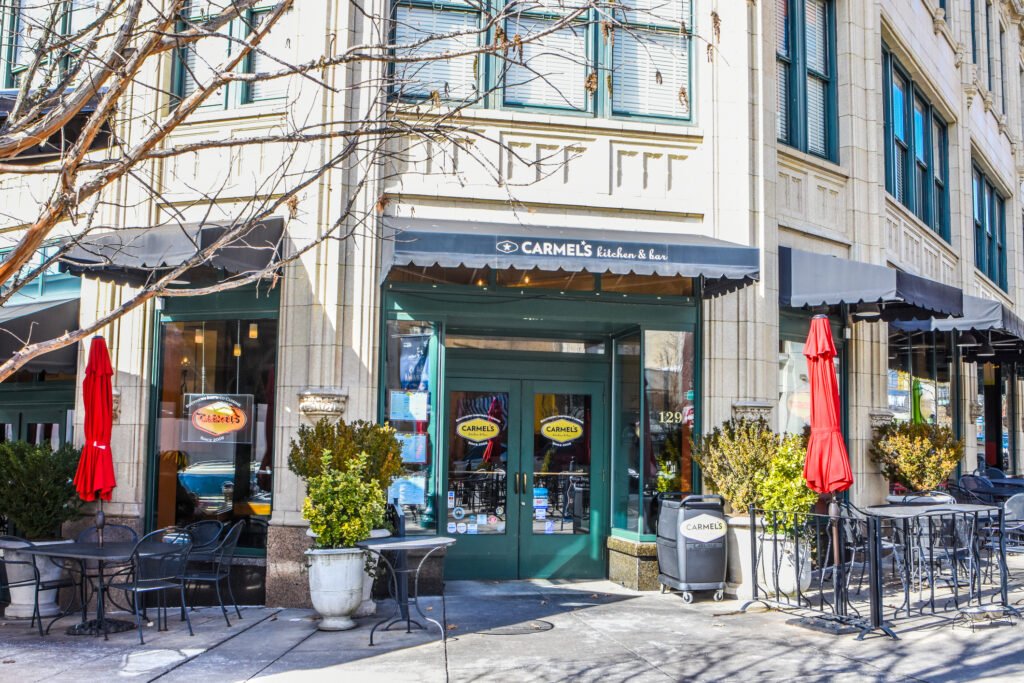Walking through Asheville, you’ll catch scents of smoked applewood and wild herbs. It’s like the city is whispering its culinary secrets. This mountain town is more than a place; it’s a feast of flavors. The Asheville food scene blends old traditions with new techniques. Here, farm-to-table meets fermentation labs, making mountain cuisine both new and true to its roots.
Your first time in Asheville might be at a twilight market, where you watch chefs transform pawpaws into creamy desserts. That’s when you realize why this city is a true culinary treasure. Dining here isn’t just about eating—it becomes a conversation between nature, history, and creativity. While places like Juniper and Blackberry Farm are well-known, the real magic lies in the hidden spots you stumble upon.
Key Takeaways
- Asheville’s dining culture merges Appalachian heritage with cutting-edge culinary arts.
- Three pillars define its identity: wild foraged ingredients, artisan fermentation, and elevated fine dining.
- Exploring Asheville offers immersion into both modern kitchens and age-old mountain cooking methods.
- Local chefs prioritize partnerships with regional farmers and indigenous foodways.
- The city’s restaurants and markets provide gateways to understanding Southern Appalachian food’s global influence.
The Appalachian Influence: Understanding Asheville’s Culinary Roots
As you walk through Asheville’s public market, you’re greeted by the smell of smoked pork and wood-fired bread. This city’s food scene pulls you into the heart of Appalachian cuisine. With every dish, you taste a story of mountain food heritage. The culinary history is not just kept alive, it’s something you help reinvent every day through each bite you take.
Mountain Heritage in Modern Plates
Local chefs mix indigenous Appalachian ingredients with modern cooking styles. They take smoked trout from mountain streams and pair it with foraged mushrooms. This dish is a modern take on old fishing traditions.
You can taste the history in each dish. From cornbread made with heirloom grits to venison glazed with local honey, every bite you take becomes a tribute to the past.
Indigenous Ingredients That Shaped Local Tastes
These plants and techniques are the heart of today’s creativity. Here’s a table of ingredients that connect past and present:
| Ingredient | Traditional Role | Modern Application |
|---|---|---|
| Ramps | Spring tonic for miners | Finely chopped in pates and infused oils |
| Pawpaws | Wild fruit for winter preserves | Baked into tarts or paired with dark chocolate |
| Cherokee Purple Tomatoes | Staple in stews and breads | Roasted and blended into smoky salsas for charcuterie |
From Subsistence to Celebration: The Evolution of Appalachian Cuisine
What once fed families now wows diners. Techniques like lard-rendering and wild herb drying are now on tasting menus. Southern mountain cooking’s simple beginnings, like beans with smoked pork, are now part of elaborate meals.
Chefs honor these traditions while making them new again. They ensure that the stories of the past continue to inspire today’s dishes.
Why Culinary Travel to Asheville, North Carolina Should Be on Your Bucket List
Your first visit to city’s streets will be unforgettable. You’ll know right away that you’ve discovered one of the best food city in America. This Asheville culinary destination blends rich tradition with bold new ideas. Picture yourself sipping a craft cocktail infused with elderflower as the sun sets over the Blue Ridge Mountain
Or picture a baker making dough the old way, but using heritage grains. These moments are common. They show you the city’s love for food.

What makes Asheville special? Its size. You can easily go from a farm-to-table brunch to a moonshine tasting in one day. Local chefs, like Laurel’s Mia Torres, create dishes with wild ramps and heirloom beans.
The city’s warmth is amazing. At Early Girl Eatery, servers talk about their farmers like family stories.
- Explore unique food experiences from foraged dinners to grain-to-glass whiskey trails.
- Meet chefs who source ingredients within 50 miles of your table.
- Discover how tradition meets creativity in every neighborhood.
Asheville’s charm is in its balance. Fine dining feels as welcoming as a local diner. Food tourism here is more than a trend—it’s a lifestyle. Come with an appetite, leave with a new perspective.
The Wild Harvest: Asheville’s Thriving Foraging Scene
As you walk through the Blue Ridge Mountains, you’ll discover that the forest floor is a pantry. In this city, foraging isn’t just a hobby, it’s a way of life. Each season offers its own treasures: spring’s ramps, summer’s morels, and autumn’s chanterelles. This is wild food at its finest, where every foraged bite tells you a story of place and season.
Seasonal Treasures in the Blue Ridge Mountains
On a guided tour, you’ll uncover the foraging secrets of the Blue Ridge Mountains. In the fall, you might spot mushrooms clinging to oak trees; in winter, you’ll discover the bold flavor of pungent spicebush berries. These wild ingredients come to life in local kitchens, think black walnut-crusted venison or restaurants serving wood sorrel sorbet made with freshly foraged finds.
Guided Foraging Tours Worth Your Time
Join experts who decode the landscape. Tours range from mushroom hunting under moonlight to workshops on edible greens. Pro tip: Book through Epicurean Escape’s curated experiences for trustworthy guides who balance education and ethics.
- Learn to distinguish toxic look-alikes during hands-on workshops
- Forage for medicinal herbs alongside Cherokee botanists
- Evening tours spotlight bioluminescent fungi under starlight
How Local Chefs Transform Foraged Ingredients
“A wild mushroom’s terroir defines its flavor—I let the forest guide my menu,” says Chef Lila Thompson of Cúrate Botánica.
Chefs like Thompson blend tradition with innovation. At Foraged, a downtown eatery, spring fiddleheads star in tempura, while autumn’s pawpaws become boozy syrups. This is wild food reimagined—where forest and fork meet with reverence.
Every bite tells you a story of place, and foraging culture ensures that story stays alive.
Fermentation Nation: The Art of Preservation in Asheville
Your journey into fermentation world might start with a sip of craft kombucha Asheville. It’s alive with the flavors of local herbs and wildflower honey. In basements and sunlit studios across the city, artisans transform time into taste, creating tangy, complex foods from the simplest ingredients.
You’ll see jars of artisanal ferments lining the shelves across North Carolina. Inside, you’ll find crisp pickles with hints of sorghum syrup and miso steeped in pawpaw purée. Each jar reflects the patient craft of turning simple ingredients into something extraordinary. Asheville’s pickle culture invites you into a world where tradition meets bold, new ideas.

The alchemy happens in the quiet: microbes working in the dark, weaving history into flavor.
Workshops in Appalachia’s foothills teach you how to make fermentation masterpieces from heirloom cabbages. You’ll to layer heirloom vegetables with local spices. Their brine is a mix of science and craft.
Fermentation workshops in Appalachia will draw you in if you want to learn the science behind sauerkraut and beet kvass. You’ll hear stories of how a chef revived a Cherokee method for apple butter. You’ll also learn how a brewer mixes Korean kimchi techniques with mountain mustard greens.
Every batch is a bridge between old and new. It honors past practices but also excites modern tastes. Fermentation is both a craft and a conversation in Asheville’s culinary heart.
Beyond Farm-to-Table: Asheville’s Commitment to Local Sourcing
Before dawn, Asheville comes alive. At the farmers markets, chefs and cooks admire fresh produce. They touch sun-warmed tomatoes and smell fresh herbs. This city lives and breathes local food .
The Farmers Markets That Feed the City
The City Market has been around for a century. It’s joined by markets like the West Asheville Tailgate Market. Each market has its own charm, from honeysuckle honey to heirloom beans. These markets are the heart of Asheville farm to table.
Restaurant Partnerships with Local Producers
Behind the scenes, chefs and farmers work together. At Root + Bone, a chef and a farm create special breads. At Juniper, a cheesemaker makes smoked gouda for a chef’s dishes. These partnerships make sustainable restaurants unique, with menus that change with the seasons.
Urban Farming Initiatives Changing the Game
Abandoned lots are now farms. In downtown Asheville, urban farming North Carolina grows microgreens for restaurants. Rooftop beehives produce honey for brunch spots. These efforts show you Asheville’s commitment to both the earth and the sky.
White Tablecloths and Mountain Views: Fine Dining Experiences
Asheville’s fine dining scene is a mix of elegance and natural charm. The best restaurants has to offer are at its core. They serve dishes that blend old traditions with new ideas.
Your favorite meal might be at a table with a view of the Blue Ridge Mountains. The tasting menu will take you on a journey through local flavors. From foraged morels to smoked Cherokee white potatoes, every bite will be unforgettable.

Tasting Menus That Tell Asheville’s Story
At Leno, dining is like reading a book. Each dish tells a part of this city’s story. They mix local ingredients with creative cooking.
The award-winning chefs focus on both taste and presentation. A single beet becomes a work of art, with its colors and textures.
Celebrated Chefs Making Their Mark
“We’re not just cooking; we’re preserving stories in saucepans,” says Chef Katie Button of Le Sel. Her use of local ingredients has earned her a James Beard nomination.
These chefs turn simple ingredients into masterpieces. At Curate, Chef Travis Grimes makes Carolina farro taste like the earth itself.
Ready to try it for yourself? Contact our concierge to plan your Asheville fine dining adventure. Every bite is a journey. Learn more.
Liquid Culture: Navigating Asheville’s Renowned Beverage Scene
Exploring flavors goes beyond food to its lively liquid culture. Craft beer lovers know Asheville’s breweries are more than just places to drink. They are where local ingredients turn into art in a glass. Places like breweries Highland Brewing and New Belgium show how ingredients become amazing beers.

Fletcher, Nc October 15, 2016 – Sierra Nevada Brewery
Craft cocktails in Asheville are like magic. At Cúrate, bartenders mix drinks with homemade shrubs and herbs. This turns a simple Negroni into a tale of the land. The wine scene has natural wine bars like Vin de Vie, where you can find crisp, unfiltered wines.
Even local spirits in North Carolina, like BrightLeaf Spirits, make bourbon aged in the Blue Ridge Mountains. This adds a special flavor to every drink.
| Category | Spot | Signature |
|---|---|---|
| Breweries | Wicked Weed Brewing | Saison fermented with local honey |
| Cocktails | Early Bird | Pawpaw-infused Old Fashioned |
| Wine | White Oak Wine Bar | Natural wines from North Carolina vineyards |
| Spirits | Double Zero | Small-batch amaro with foraged botanicals |
“Every pour here ties to this place,” said a mixologist at Pour Boys Listen, blending a gin made from reclaimed botanicals. “We’re turning waste into vermouth.”
Asheville’s liquid culture is alive and thriving. From cideries using old apple varieties to bars making non-alcoholic drinks with wild herbs, it’s a place where nature meets creativity. Here, every drink tells you a story of the mountains and the people who make them.

Carmel`s Kitchen And Bar In Asheville, North Carolina.
Hidden Gems: Neighborhood Eateries Locals Swear By
Asheville’s best meals aren’t always in fancy restaurants. The city’s hidden restaurants are in quiet spots where locals eat with love. These neighborhood restaurants are the city’s heart. They offer fresh bread and sizzling meat, making every bite a secret shared.
West Asheville’s Unpretentious Delights
In West Asheville dining, simplicity meets perfection. At The Grit & Grind, the oven’s sound welcomes you. Next door, Love & Death Tacos makes tacos that taste like a favorite song. Here, chefs know their neighbors and make menus that are both simple and deep.
River Arts District Food Discoveries
In the River Arts District, food shines in old warehouses. Blackbird Restaurant turns these spaces into art with dishes like smoked trout. These places feel like home, with food that’s both simple and personal.
Downtown Treasures Beyond the Tourist Trail
Under downtown’s busy streets, Asheville hidden restaurants hide in secret doors. Smiling Lizard Ramen is in a basement, with broth that’s been simmering for years. Upstairs, Greyhound Coffee & Catering offers biscuits with local cheese and stories. These spots connect Asheville’s past and present.
| Neighborhood | Spot | Specialty | Why It’s a Gem |
|---|---|---|---|
| West Asheville | The Grit & Grind | Sourdough + Heritage Pork Tacos | Community-driven, no reservations needed |
| River Arts District | Blackbird Restaurant | Smoked Trout, Fermented Sides | Industrial-meets-soulful dining |
| Downtown | Smiling Lizard Ramen | Basement-Brewed Broths | Hidden in plain sight, rich with history |
These neighborhood restaurants are more than food. They’re conversations. At Greyhound, mugs clink, and in West Asheville, laughter fills the air. In repurposed factories, creativity hums. Every dish shows a city that eats with its hands and heart.

Spring Fling Festival Decorations. Vibrant Handmade Crafts And Colorful Banners Adorn The Spring Fling Festival In Asheville, North Carolina, Surrounded By Blooming Wildflowers.
Seasonal Celebrations: Food Festivals That Define Asheville
Asheville is a feast for the senses all year round. Its food festivals and culinary events are more than just food. They open doors to the region’s heart and soul. Imagine autumn’s cool air filled with joy at the Mountain Apple Days, where cider is made from old apple varieties.
This is the magic of Asheville seasonal celebrations. Each event weaves tradition with new ideas.
| Season | Festival | Highlights |
|---|---|---|
| Spring | Ramps & Roots Festival | Wild greens tastings, foraging demos |
| Summer | Heritage Tomato Faire | Heirloom varieties, jam-making workshops |
| Autumn | Mountain Apple Days | Cider tastings, orchard tours |
| Winter | Spice & Smoke Market | Local preserves, artisanal spices |
“These festivals are where strangers become kin over a shared bite,” said Chef Elena Marquez, a local culinary guide. “They’re more than events—they’re living history.”
Make sure to check out the Asheville food calendar for these special times. Spring’s ramps festivals offer wild greens with bourbon pairings. Winter’s markets are filled with spiced ginger liqueurs. Each event is a piece of the North Carolina food festivals story, celebrating both the earth and our spirits. Look up the food calendar for dates and join in. The best moments come when you taste the season itself.
Where Culinary Travelers Should Stay in Asheville
Choosing the right Asheville culinary lodging makes your visit special. Imagine waking up to the smell of sourdough or enjoying local coffee. The best Asheville accommodations for foodies become part of your journey.
Hotels with Exceptional Dining Programs
At food-focused hotels like The Omni Grove Park Inn, dining is a highlight. Their restaurants use local ingredients for tasting menus. You can enjoy dishes inspired by the Blue Ridge.
Food-Focused Bed and Breakfasts
At places like The Dewdrop Inn, breakfast is an adventure. Owners, who used to be chefs, serve dishes with local tomatoes and charcuterie.
“Our preserves are made from what grows wild here,” says the innkeeper, “so every bite connects to this land.”
Vacation Rentals with Dream Kitchens
For those who love to cook, Asheville kitchen rentals like The Chef’s Cottage are perfect. They have top-notch appliances and local ingredients. It’s like cooking in Verona, but with Asheville’s flavors.
Whether you’re enjoying a chef’s tasting or cooking in your kitchen, these places are more than a place to stay. They’re where your next memory will be made.
Conclusion: Crafting Your Personal Asheville Food Journey
Asheville’s food scene is more than just a visit; it’s an adventure. You can explore from forest to table or mix tasting menus with moonshine. Your trip should show your love for discovery.
Embrace Asheville’s mix of old and new. Enjoy farm-to-table meals and innovative labs in historic mills. Every bite tells you a story of tradition and place.
Start by finding what you love. Try foraging tours or farm visits. Then, create a tour that fits your interests. Mix a morning market with evening cocktails for a perfect day.
Be flexible. Wander into West Asheville’s taco trucks or book a tasting menu months in advance. The city is easy to explore on foot.
Plan your visit with the seasons in mind. Spring is for ramps, and autumn is for cider. Use local tips to find the best spots.
Ask chefs for their favorite places. Book farm stays for workshops. Asheville’s flavors are hidden in small cafes and craft breweries.
Your travel in Asheville will teach you to follow the local rhythms. Enjoy a coffee by the river and then visit the roaster. This way, you can taste the soul of Asheville.
Your adventure is waiting. Let every meal be a conversation with the land and its people.


